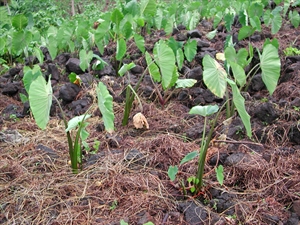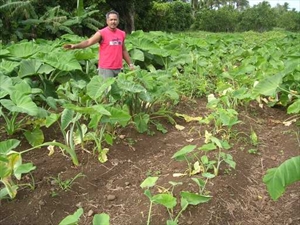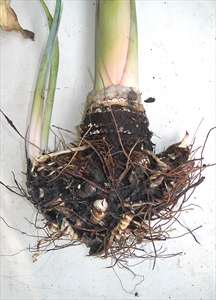Taro root rot, cocoyam root rot, Pythium root rot of taro (cocoyam)
Pacific Pests, Pathogens and Weeds - Online edition
Pacific Pests, Pathogens & Weeds
Taro root rot (044)
Pythium species
Wherever taro (Colocasia esculenta) or Xanthosoma sagittifolium (both called cocoyam in Africa) are grown. The main species is Pythium myriotylum. This species has been recorded from taro in Fiji, Samoa, and Solomon Islands, from Alocasia macrorrhizos in Samoa, and from Xanthosoma sagittifolium in Solomon Islands. Wilts have been reported on Xanthosoma saggitifolium in Cook Islands and Vanuatu, but the cause remains to be confirmed. In West Africa, Pythium myriotylum causes a serious wilt disease of Xanthosma saggitifolium but, apparently, not on Colocasia esculenta. It may be a separate Pythium species.
Taro (Colocasia esculenta); giant taro (Alocasia macrorrhizos ); and cocoyam (Xanthosoma sagittifolium). Many other plants are infected in the field, including beans, capsicum, ginger, peanuts and pineapple. Pythium species cause a damping-off disease in the nursery affecting a wide range of plants before and after seedlings emerge from the soil (see Fact Sheet No. 47).
Pythium species are soil borne pathogens that attack the roots and underground parts of many plants. They are not fungi, but belong to the oomycetes or water moulds, and are related to algae.
The first sign of the disease in mature plants is the drying up of the outer older leaves (Photo 1). As the disease progresses, the number of leaves declines, young leaves are shorter and smaller than usual, and eventually the plant can be pulled easily from the soil (Photos 2&3). Roots are absent on these plants or only present at the very top of the corm (Photos 4&5). In young plants, growth is slow, and plants remain with one or two leaves for months, as the roots are destroyed as soon as they are produced (Photo 6). Corm rots may be present, but this is a late symptom.
Pythium has a wide host range and can infect many crops and weeds. When conditions are not favourable or when susceptible hosts are not present, Pythium produces resistant spores - 'oospores' - that remain alive but inactive in the soil for many years. They germinate when conditions are right and produce swimming spores in large numbers which infect the roots of susceptible plants. The disease is especially severe on plants grown in waterlogged soils.
Root rot is the most important disease of cocoyam (Xanthosoma) worldwide. It is particularly important in West Africa and in Central America. It has been recorded in several Pacific countries. It is a problem in East New Britain, Papua New Guinea, and has been recorded in Cook Islands and Vanuatu. Taro (Colocasia) root rot occurs worldwide, but in the Pacific, at least, it is a minor disease.
Carefully dig up the plants, do not pull them from the ground. Look to see if roots are decayed, especially the small feeder roots; these are the roots that take water and minerals from the soil and supply the leaves. Without these roots, the leaves wilt and die.
CULTURAL CONTROL
Cultural control is important. The following should be done:
Before planting:
- Choose sites carefully. Do not plant where the land is likely to flood, or where water will remain for several days after heavy rains.
- Preferably, avoid heavy clay soils; where this is not possible, make drains around the plots or plant the taro on raised beds or mounds to assist drainage.
- If there are soil types where the disease is rare, use these. It is known from West Africa that some soil types produce healthy crops, whereas crops in others always become badly diseased. It is likely that in the beneficial soils there are microorganisms that destroy Pythium.
- Do not plant Xanthosoma or Colocasia taro in land below where root rot occurred previously. If you do, spores of the water mould will spread in soil or surface water during rains.
- Grow a ground legume before planting taro, such as Mucania or Pueraria. The build-up of organic matter in the soil, may increase microbes antagonistic to Pythium.
During growth:
- If a disease outbreak occurs, especially at an early stage in the crop development, it is better to pull out all the surviving plants, 'clean' them by removing roots, old leaves and soil, and replant in another garden. Doing this may prevent the loss of the entire crop.
- The addition of lime may be helpful. In soils low in calcium, e.g., the lava soils of Samoa, add lime at the rate of 20 g per m2. The increase in calcium rather than an increase in pH is the main benefit at this rate. The calcium is needed for cell wall development. The use of white coral sand has been suggested in Samoa.
After harvest:
- If planting material is taken from plants that have shown root rot symptoms, carefully remove all the roots, old leaves and soil, before planting in a new garden.
- Collect and destroy any debris remaining from the crop and burn it.
RESISTANT VARIETIES
Varieties of cocoyam have been reported with tolerance from West Africa. A yellow corm variety from Nigeria with poor eating characteristics has resistance, and is undergoing quarantine treatments at the CePaCT lab Secretariat for the Pacific Community. Colocasia taro varieties with resistance are known from Samoa, but these varieties (Tusi Tusi, Talo Vale, Pute Mu and Pula Sama Sama) are susceptible to taro leaf blight. Varieties with tolerance to the disease are also reported from Hawai'i.
CHEMICAL CONTROL
Fungicides are not recommended for the control of this disease; they are unlikely to be economic. By the time that symptoms appear, damage to the roots has already occurred. It is best to carry out the cultural control recommendations stated above.
If a fungicide was required, phosphorous acid could be tried. Although its direct action on Pythium is not as potent as that on Phytophthora, it may stimulate the production of chemicals by the plant (called 'elicitors') which improve its defense against Pythium and other organisms.
Alternatively, apply metalaxyl; this can be applied in two ways: i) as a spray in water at planting (1.2 to 2.4 L/ha active ingredient); and/or ii) as a dip of the planting 'tops' to eliminate the Pythium oomycete by placing them in 0.1-0.4 g/L Ridomil (approximately, 0.05-0.2 g/L metalaxyl), and left overnight before planting).
In each case, the roots should be removed before the application of the chemical treatments.
____________________
When using a pesticide, always wear protective clothing and follow the instructions on the product label, such as dosage, timing of application, and pre-harvest interval. Recommendations will vary with the crop and system of cultivation. Expert advice on the most appropriate pesticide to use should always be sought from local agricultural authorities.
AUTHORS Helen Tsatsia & Grahame Jackson
Information from Jackson GVH, Gerlach WWP (1985) Pythium rots of taro. South Pacific Commission. Noumea, New Caledonia. (https://lrd.spc.int/component/docman/cat_view/137-all/128-plant-health-/276-pest-advisory-leaflets?start=30); and Ooka JJ (undated) Taro diseases. Research extension series. Hawaii Institute of Tropical Agriculture and Human Resources. Honolulu. Hawaii. (https://core.ac.uk/download/pdf/5095157.pdf); and from Carmichael A, et al. (2008) TaroPest: an illustrated guide to pests and diseases of taro in the South Pacific. ACIAR Monograph No. 132, 76 pp. (https://lrd.spc.int/about-lrd/lrd-project-partners/taropest); and from Biosecurity Australia (2011) Review of import conditions for fresh taro corms. Biosecurity Australia, Canberra. (https://www.agriculture.gov.au/sites/default/files/sitecollectiondocuments/ba/plant/2011/taro/Review_of_Import_Conditions_for_Fresh_Taro_Corms_clean.pdf). Photo 3 William Wigmore and Maja Poeschko, Ministry of Agriculture, Cook Islands.
Produced with support from the Australian Centre for International Agricultural Research under project PC/2010/090: Strengthening integrated crop management research in the Pacific Islands in support of sustainable intensification of high-value crop production, implemented by the University of Queensland and the Secretariat of the Pacific Community.









